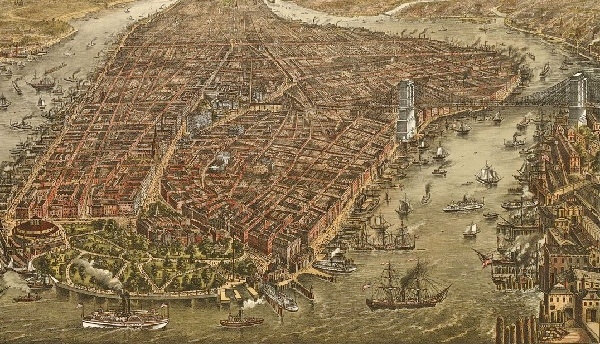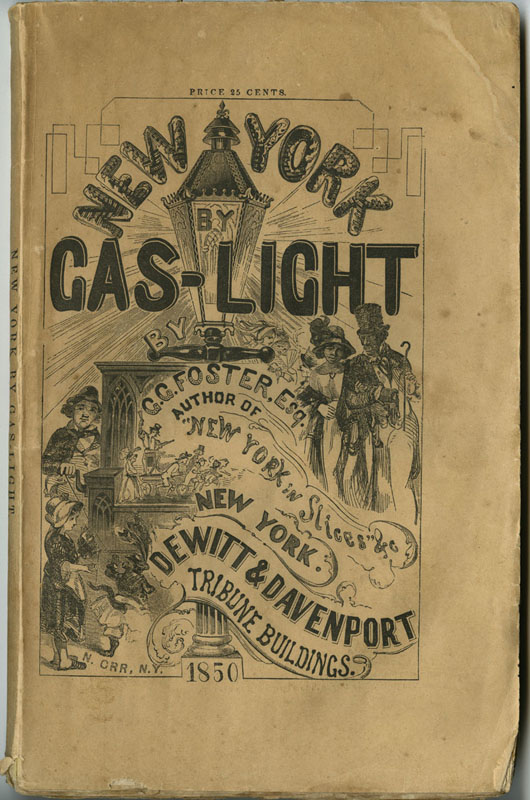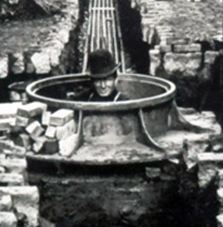New York, Manhattan, Metropolitan, Municipal, Knickerbocker and Harlem gas companies merged in 1884.
The history of Con Edison includes stories of work crews from New York City’s many competing gas companies digging up lines of rivals — and literally battling for customers, giving rise to the term “gas house gangs.”

Competing New York City manufactured gas companies provided lighting beginning in 1823. This 1873 “bird’s eye view” illustrates New York and Brooklyn. The Brooklyn Bridge, under construction from 1870 to 1883, is at right. Courtesy Library of Congress.
Still among the nation’s largest gas utility companies, Consolidated Edison, Inc. — known as “Con Edison” or “Con Ed” — began on November 11, 1884, when six New York City gas-light companies merged (New York, Manhattan, Metropolitan, Municipal, Knickerbocker and Harlem).
But New York’s giant utility can trace its history more than six decades earlier to the New York Gas Light Company, which provided manufactured gas (also called town gas) by distilling coal.
America’s first public street lamp using manufactured gas illuminated Baltimore, Maryland, in 1817, making the Gas Light Company of Baltimore the first U.S. commercial gas lighting company. Its plant distilled tar and wood to create the gas.
In Pennsylvania, employees of the newly formed Philadelphia Gas Works in 1836 ignited 46 “coal gas” lights along the city’s Second Street (learn more in Illuminating Gaslight).
New York City Gas Light
“Before the Brooklyn Bridge spanned the East River, before the Statue of Liberty first graced New York Harbor, and before skyscrapers rose above New York City’s streets, the utility companies that would eventually become Con Edison were already building the energy infrastructure needed to fuel and sustain the city’s growth,” notes a company historian.

Published in 1850, when the population of New York reached 500,000, “New York by Gas-Light” featured bowling alleys, dance halls, saloons and theaters.
In 1823, New York Gas received a charter from the New York State Legislature to serve all of Manhattan south of an east-west line created by Grand, Sullivan, and Canal Streets.
“Like most early gas companies, New York Gas would focus its efforts on street lighting, in this case, supplementing or replacing the whale oil lamps that were installed by the city beginning in the 1760s,” according to Con Edison.
Manufacturing gas from coal, in 1833 the Manhattan Gas Light Company began to provide service to Manhattan above Grand and Canal streets.
Gas House Gangs
Another New York City “coal gas” company came on the scene in 1855 when the Harlem Gas Light Company received a city franchise to serve customers north of 79th Street. In 1858, the Metropolitan Gas Light Company got a city-wide charter and went into direct competition with the existing gas companies.
More companies organized, including New York Mutual Gas Light in 1866 and the Municipal Gas Light Company in 1876. “With six major gas companies serving New York City, the streets were constantly being torn up by one company or another installing or repairing their own mains – or removing those of a rival,” explains the Con Edison website.
From time to time, work crews from competing companies would inadvertently meet on the same street and literally battle for customers, adding a new urban phrase, “gas house gangs.”

Conflicts between crews from competing companies gave rise to the term “gas house gangs.”
“In May 1880, the city’s major gas companies reached an agreement on the price of gas and ended the construction of competitive mains,” the website adds. “It was a business arrangement that would be unlawful today but was legal, and sensible at the time.”
Electrification of New York
Just as company executives were looking forward to the financial stability and profitability the agreement would bring, a new problem was just beginning.
In December 1879, Thomas Edison had demonstrated his newest invention — the incandescent light bulb. As electric lamps quickly became the light of choice (replacing gas and kerosene lamps), the New York gas companies countered by finding new uses for their product, especially using gas for heating and cooking.
But the future survival of the gas business seemed to depend on joining forces. Consolidated Gas Company would result from the November 11, 1884, merger of New York, Manhattan, Metropolitan, Municipal, Knickerbocker and Harlem gas companies.
Through the years, the company acquired more manufactured gas — and natural gas — ventures along with electric companies (including Edison’s) to serve New York City and Westchester County. It became Consolidated Edison Company of New York in the mid-1930s.
“By 1932, New York Edison’s parent company, Consolidated Gas, was the largest company in the world providing electrical service,” concludes the company website. “In 1936, with electric sales far ahead of gas sales, Consolidated Gas changed its name to the Consolidated Edison Company of New York, Inc.”
In 2020, Con Ed distributed steam, electricity and natural gas to more than one million customers in Manhattan, the Bronx, Queens, and most of Westchester County. More than 4,200 miles of gas mains and nearly 400,000 service pipes transported natural gas from fields in Texas, Louisiana, and the Gulf of Mexico.
Learn about the history of New York’s petroleum industry — which began in 1865 — at the Pioneer Oil Museum of New York in Bolivar.
_______________________
Recommended Reading: In Pursuit of Fame: Rembrandt Peale, 1778-1860 (1993); The Extraction State, A History of Natural Gas in America (2021); Empire Oil: The Story of Oil in New York State (1949). Your Amazon purchase benefits the American Oil & Gas Historical Society. As an Amazon Associate, AOGHS earns a commission from qualifying purchases.
_______________________
The American Oil & Gas Historical Society (AOGHS) preserves U.S. petroleum history. Please become an AOGHS annual supporter and help maintain this energy education website and expand historical research. For more information, contact bawells@aoghs.org. Copyright © 2024 Bruce A. Wells. All rights reserved.
Citation Information – Article Title: “History of Con Edison.” Authors: B.A. Wells and K.L. Wells. Website Name: American Oil & Gas Historical Society. URL: https://aoghs.org/stocks/con-edison-american-utility-company. Last Updated: November 10, 2024. Original Published Date: April 29, 2013.



